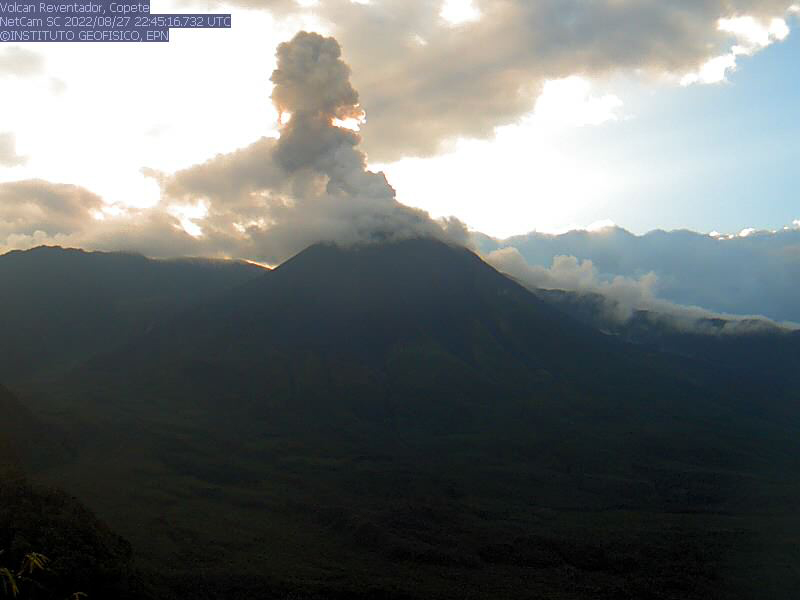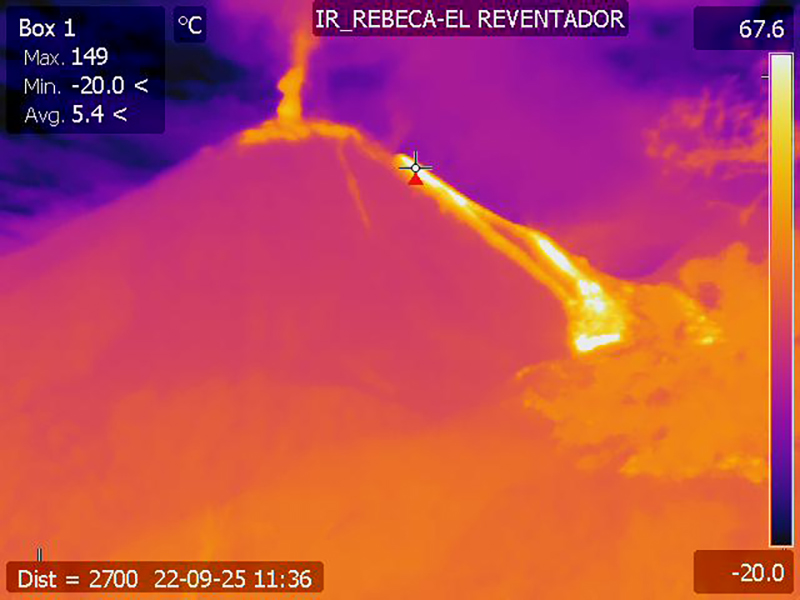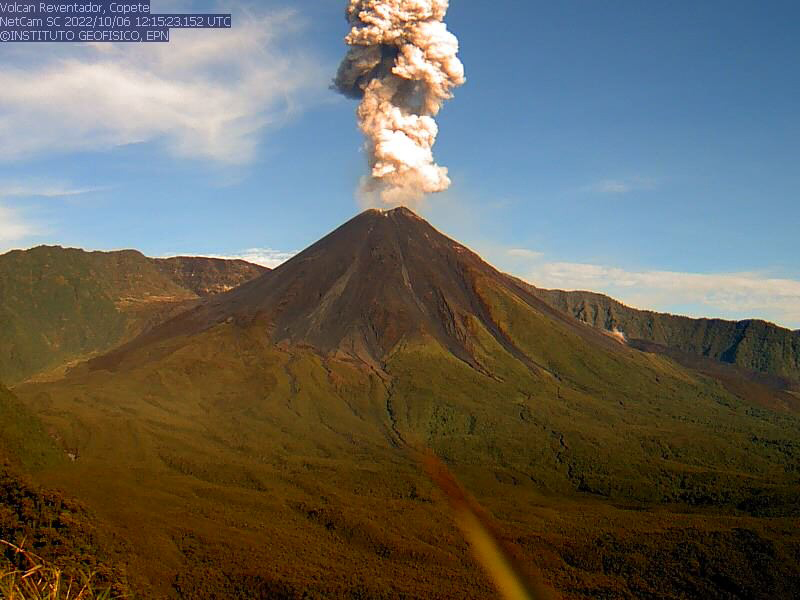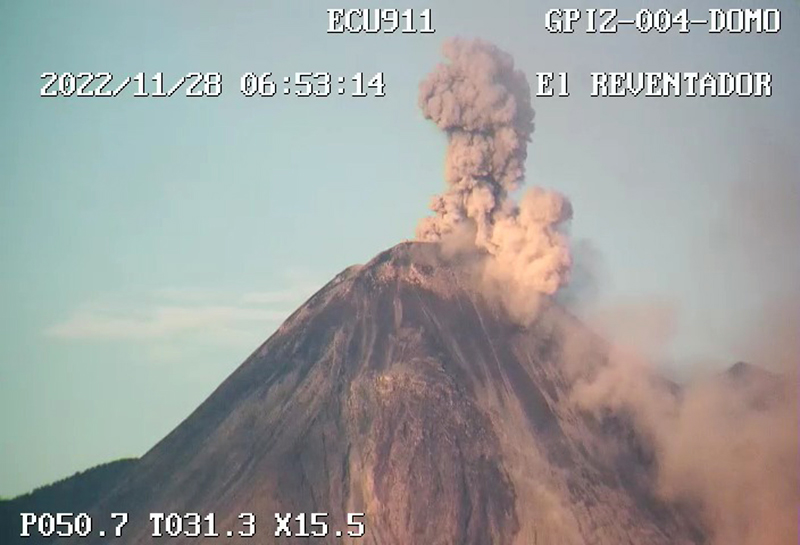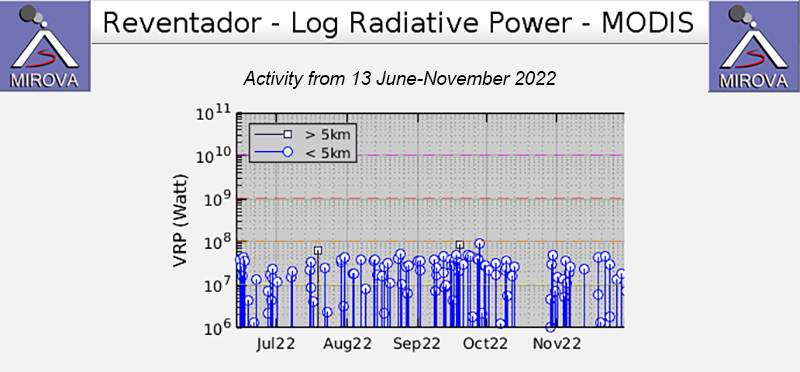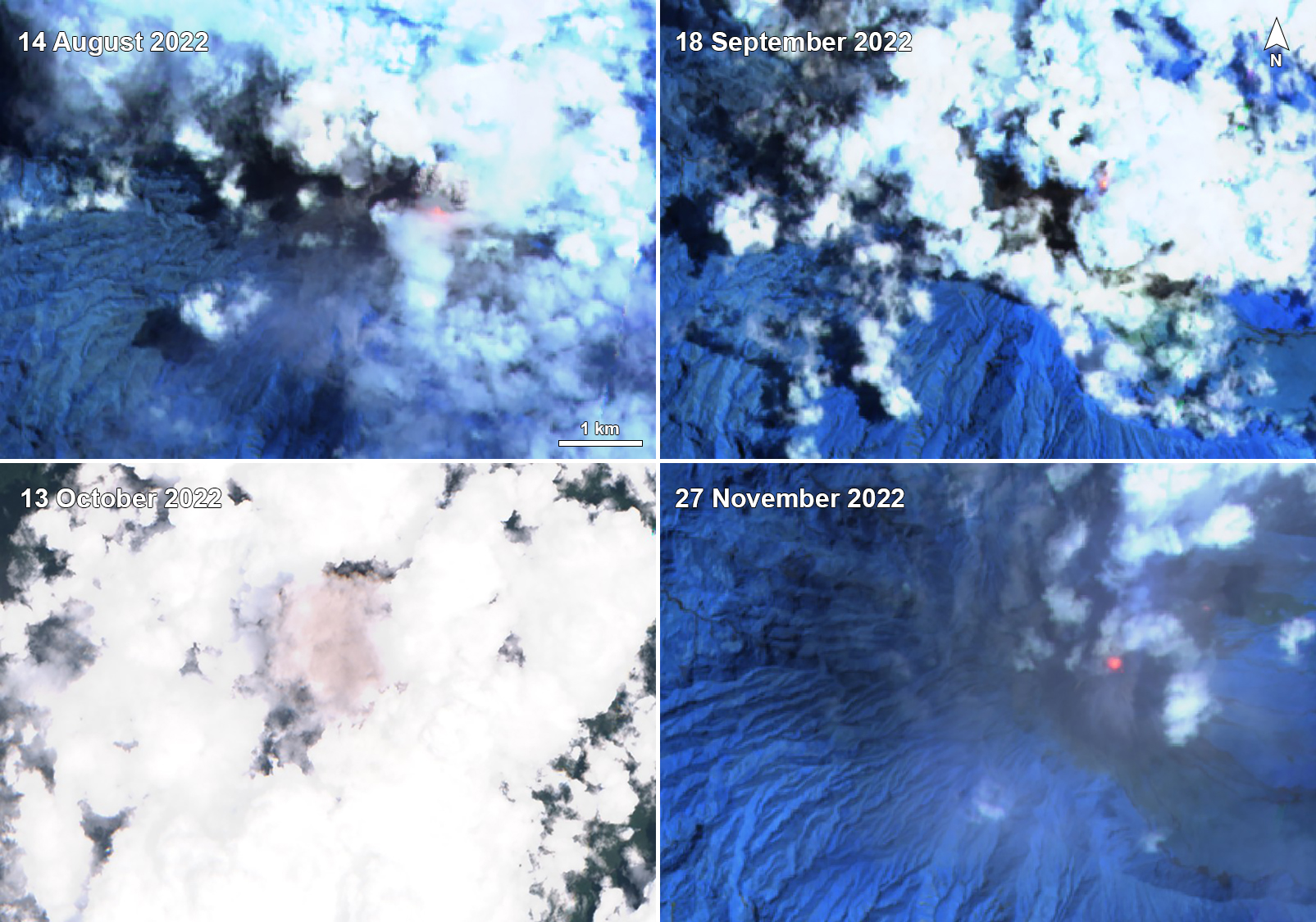Report on Reventador (Ecuador) — February 2023
Bulletin of the Global Volcanism Network, vol. 48, no. 2 (February 2023)
Managing Editor: Edward Venzke.
Edited by Kadie L. Bennis.
Reventador (Ecuador) Daily explosions, ash plumes, lava flows, and block avalanches during August-November 2022
Please cite this report as:
Global Volcanism Program, 2023. Report on Reventador (Ecuador) (Bennis, K.L., and Venzke, E., eds.). Bulletin of the Global Volcanism Network, 48:2. Smithsonian Institution.
Reventador
Ecuador
0.077°S, 77.656°W; summit elev. 3562 m
All times are local (unless otherwise noted)
Volcán El Reventador, located in Ecuador, includes a 4-km-wide avalanche scarp open to the E. Recorded eruptions date back to the 16th century and have been characterized by explosive events, lava flows, ash plumes, and lahars. Frequent lahars in this region of heavy rainfall have built deposits on the scarp slope. The largest recorded eruption took place in 2002, producing a 17-km-high eruption column, pyroclastic flows that traveled up to 8 km, and lava flows from summit and flank vents. The current eruption began in July 2008 and more recently has consisted of frequent explosions, ash plumes, lava flows, and incandescent block avalanches (BGVN 47:09). This report covers similar activity of daily explosions, ash plumes, and incandescent block avalanches during August through November 2022 using daily reports from Ecuador's Instituto Geofisico (IG-EPN), the Washington Volcano Ash Advisory Center (VAAC), and satellite data.
During August through November 2022, IG-EPN reported daily explosions, gas-and-steam and ash plumes rising 300-1,500 m above the crater, and frequent crater incandescence, often accompanied by incandescent block avalanches and lava flows that traveled down the NE, E, and SE flanks. On average, there were more explosions detected during August through September compared to October through November.
Table 16. Monthly summary of explosions and plume heights recorded at Reventador from February through November 2022. Data courtesy of IG-EPN (August-November 2022 daily reports).
| Month | Average number of explosions per day | Max plume height above the crater rim (m) |
| Aug 2022 | 41 | 400-1,200 |
| Sep 2022 | 40 | 600-1,500 |
| Oct 2022 | 27 | 300-1,200 |
| Nov 2022 | 30 | 500-1,500 |
Activity during August consisted of explosions, ash plumes, crater incandescence, and avalanches of material, though cloudy weather sometimes obscured views of the summit. There were 16-65 daily explosive events, which generated ash emissions that rose 400-1,200 m above the summit and drifted NW, W, WSW, SW, and N (figure 163). The Washington VAAC reported that ash plumes rose 688-2,800 m above the summit and drifted W, NW, and SW. Frequent nighttime crater incandescence was observed at the summit. There were 20-87 long period (LP) earthquakes and 1-30 emission tremors (signals indicating steam) detected. A continuing active lava flow moving NE was reported during 2-4 August. During 3-4 and 6-8 August incandescent block avalanches descended 500-700 m from the crater. During the nights of 11-13 August incandescent block avalanches rolled as far as 400 m from the crater on all flanks. Incandescent avalanches traveled 600 m on the NW flank during 15-16 August. Incandescent material was observed on all flanks during the morning of 22 August as far as 500 m from the crater. During the night and early morning of 24-25 August crater incandescence was accompanied by a block avalanche along the NE flank extending 500 m from the crater. On 25 August an ash plume rose 300 m above the crater and drifted NW. During 28-29 August crater incandescence and an incandescent avalanche was observed moving 600 m from the crater on all flanks.
Similar activity was reported during September, with 18-79 daily explosions producing gas-and-ash plumes 600-1,500 m above the crater that drifted W, NW, N, SW, and NE. Nighttime crater incandescence was often observed. There were 17-92 LP earthquakes and 1-22 emission tremors detected during the month. During 31 August-2 September incandescent blocks rolled 500-600 m from the crater; during 2-3 September the blocks moved down the NE flank. According to the Washington VAAC, ash plumes rose 688-1,700 m above the crater and drifted W, NW, N, NE, and SW. Incandescent block avalanches were reported on all flanks during 4-5, 14-15, 17-19, 21-23, and 25-28 September moving 400-800 m from the crater. During 7-8 September incandescent block avalanches on the S flank rolled as far as 500 m from the crater. On 19 September an incandescent block avalanche descended 600 m on the NE flank and on 20 September an incandescent block avalanche descended 800 m on the E and ESE flank. During 22-25 September IG-EPN reported that the active lava flow on the NE flank persisted (figure 164). An incandescent block avalanche on the SE flank reached 600 m from the crater during 29-30 September.
During October, there were 7-66 daily explosions detected, generating gas-and-ash plumes that rose 300-1,200 m above the crater and drifted N, W, NW, SW, NE (figure 165). There were 2-157 LP earthquakes and 3-25 emission tremors detected throughout the month. Nighttime crater incandescence was often visible throughout the month. The Washington VAAC reported that ash plumes rose 988-2,500 m above the crater and drifted in multiple different directions. Based on data from a thermal camera, IG-EPN reported on 1-6, 10-11, 13-18, 22-27 October that the lava flow on the NE flank remained active. During 8-9 October a lava flow was observed along the E flank. Incandescent block avalanches were observed during 15-17 October that rolled 400-700 m below the crater on all flanks.
Activity continued during November, with 18-60 daily explosions producing gas-and-ash plumes that rose 500-1,500 m above the crater (figure 166) and drifted in several directions, though cloudy weather often obscured clear views. Overall, there were 22-87 LP earthquakes and 2-19 emission tremors detected during the month. Crater incandescence was often visible during nights and early mornings. According to notices from the Washington VAAC, ash plumes rose 688-2,200 m above the crater and drifted in different directions. The lava flow on the NE flank remained active during 1-2, 8-10, 15, 18-20 November. During 6-7 November crater incandescence was accompanied by incandescent block avalanches descending all the flanks and an active lava flow on the SE flank. On 9 November an incandescence avalanche was reported on the N flank. On 10 and 17 November incandescent material was reported on all flanks moving as far as 500-800 m from the crater.
Additional satellite data. MIROVA (Middle InfraRed Observation of Volcanic Activity) analysis of MODIS satellite data showed intermittent moderate thermal anomalies throughout the reporting period (figure 167), which was most likely caused by the frequent incandescent block avalanches and lava flows that were visible on multiple flanks. Additionally, the MODVOLC system identified a total of 20 thermal hotspots on 14, 16, 24, and 28 August, 23, 24, and 28 September, 2, 9, and 10 October, and 5, 6, and 22 November. Although the summit was often obscured by clouds, Sentinel-2 infrared satellite images also showed some thermal activity in the crater (figure 168). Using Sentinel-5P TROPOMI data processed by the MOUNTS (Monitoring Unrest From Space) system, and the DOAS (Differential Optical Absorption Spectroscopy) network, IG-EPN noted that the greatest volume of sulfur dioxide emissions was measured on 19 November, with 2,033 tons. Other sulfur dioxide measurements ranged from 0.1 to 824 tons.
Geological Summary. Volcán El Reventador is the most frequently active of a chain of Ecuadorian volcanoes in the Cordillera Real, well east of the principal volcanic axis. The forested, dominantly andesitic stratovolcano has 4-km-wide avalanche scarp open to the E formed by edifice collapse. A young, unvegetated, cone rises from the amphitheater floor to a height comparable to the rim. It has been the source of numerous lava flows as well as explosive eruptions visible from Quito, about 90 km ESE. Frequent lahars in this region of heavy rainfall have left extensive deposits on the scarp slope. The largest recorded eruption took place in 2002, producing a 17-km-high eruption column, pyroclastic flows that traveled up to 8 km, and lava flows from summit and flank vents.
Information Contacts: Instituto Geofísico, Escuela Politécnica Nacional (IG-EPN), Casilla 17-01-2759, Quito, Ecuador (URL: http://www.igepn.edu.ec/); MIROVA (Middle InfraRed Observation of Volcanic Activity), a collaborative project between the Universities of Turin and Florence (Italy) supported by the Centre for Volcanic Risk of the Italian Civil Protection Department (URL: http://www.mirovaweb.it/); Hawai'i Institute of Geophysics and Planetology (HIGP) - MODVOLC Thermal Alerts System, School of Ocean and Earth Science and Technology (SOEST), Univ. of Hawai'i, 2525 Correa Road, Honolulu, HI 96822, USA (URL: http://modis.higp.hawaii.edu/); Sentinel Hub Playground (URL: https://www.sentinel-hub.com/explore/sentinel-playground); MOUNTS Project (Monitoring Unrest From Space), an operational monitoring system for volcanoes using Sentinel satellite data from ESA's Copernicus, Open Access Hub, hosted at UNAM and CT TU-Berlin (URL: http://www.mounts-project.com/home).


